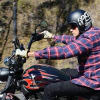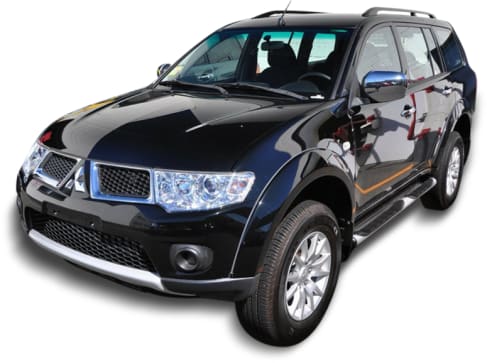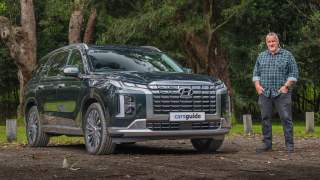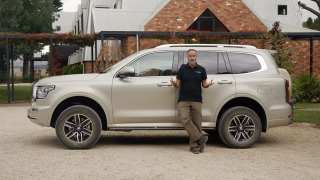
Mitsubishi Challenger 2009 Review
- Mitsubishi Challenger
- Mitsubishi Challenger 2009
- Mitsubishi Challenger Reviews
- Mitsubishi Reviews
- Mitsubishi SUV Range
- SUV
- Mitsubishi
- 7 seater
Challenger project manager Kazuhiro Notani described the new PB Challenger as an ‘all-round SUV’ with good performance in the city and bush, versatile accommodation for families and stylish looks. He says it was developed for the growing SUV markets in Australia, Russia, South America, the Middle East and Asia where demand for large SUVs had decreased but small and medium SUVs were growing.
"Growth is higher in the serious off-roaders rather than in soft crossovers," he says. "In Australia you need a serious SUV but it needs to be stylish, too.
Mitsubishi Motors Australia Ltd (MMAL) CEO and president Robert McEniry says the Challenger fits between their Outlander and Pajero, but is not a soft crossover. "It's not a pretend off-road vehicle like a lot of its competitors," he says.
"It has style and is an urban living vehicle but also a real 4WD vehicle." Challenger product manager James Toll says the main rivals were the Ford Territory, Toyota Kluger and Nissan Pathfinder. "It's not too big and not too small," he says. "We see this car as breaking down the stereotypes of SUVs."
Variants and pricing
The Challenger hits the market at a starting list price of $44,490 for the LS five-speed manual. Add $2000 for the five-speed auto and a further $2400 for the auto with seven seats.
The XLS range — available only in automatic — adds leather upholstery, satellite navigation, reverse camera and parking sensors, mud flaps, privacy glass, headlight washers, Bluetooth, upgraded sound system with video input, some exterior and interior bling and five-year premium roadside assistance. The five-seater XLS costs $56,990 and the third row of seats adds $1600.
Drivetrain
While the previous model from 1998-2006 was powered by a three-litre V6 petrol engine, this one only comes with the 2.5-litre common-rail turbo diesel powerplant from the Triton. It delivers 131kW of power and 400Nm of torque 2000rpm in the base model manual, but 350Nm of torque at 1800rpm in the four automatic models.
Platform and ability
Although it is built on a new platform, other similarities with the Triton are that it is also built in Thailand, and has the same front suspension, front chassis, transmission, rear axle and Super Select 4WD system. Challenger has a lift-up tailgate rather than a swing door, which Tol says made it better for towing.
It also features a 2500kg braked towing capacity compared with the Triton's 3000kg, but Tol says that could be increased to 3000kg under warranty after further testing. Off-road capabilities are enhanced by its ladder-frame chassis, Mitsubishi's Super Select 4WD system with a central diff and a push-button locakable rear diff with a 1.9 ratio low range, high clearance, massive wheel wells and good approach, departure and ramp breakover angles. High-range 4WD can be selected from 2WD at speeds up to 100km/h.
Design and fit-out
The exterior is stylish with a high waistline, narrow windows but good visibility, high-set headlights and taillights and flared guards. It sits high on its wheels, but this is well disguised by the high silhouette. It comes in eight colours. Inside is equally stylish with a healthy range of features in the LS and a bounty of creature features in the XLS.
Seats are comfortable, head and shoulder room is good, and legroom is plentiful even in the third row which features a 50-50 split. Behind that there is still room for a couple of large old-fashioned suitcases with the spare tyre under the rear.
Seven-seater models also get rear airconditioning and under-floor storage compartments. Standard safety features include six airbags, and stability and traction control. Tol says there were no options, but a wide range of accessories.
Sales outlook
McEniry says dealer response to the Challenger had been "excellent". "I'm confident we will have success with this model," he says. "The order lines are open and we have already exceeded our wildest expectations."
Tol says the LS would represent about 75-85 per cent of sales. He says they could attract customers from Outlander moving up, Pajero owners downsizing or owners of large cars such as Falcon, Commodore and Mitsubishi's former 380 and Magna models.
Driving
To highlight its ‘serious’ off-road potential, the vehicle was launched in Queensland with demonstrations at the 290-hectare Scenic Rim Adventure Park, near Beaudesert. The park features steep terrain, sandy loam soil, rock climbs and dramatic drop-offs. The Challenger met all challenges with ease.
Surprisingly the Bridgestone Dueller H/T (highway terrain) tyres had plenty of grip even on the steep downhill loam sections, yet also remained quiet on the tar highway transport stages of the launch. While the tyres were quiet and the wind noise low, the diesel powerplant groans loudly and coarsely under load and the automatic transmission accompanied it with vibration noises.
The auto box also flared and hunted a bit through its soft change points. It is better to ‘manually’ select the ratios in sport mode. The manual transmission was quiet, but the shift gate is huge and the clutch throw is heavy and long. Steering is quite sharp on the road, but turning circle is wide. The wheel is adjustable for height only, not reach.
Brakes are a bit spongy and lack bite for road conditions. They are more suited to off-road conditions where you don't want sudden response.
The ABS system changes its character when the vehicle is in high-range four-wheel drive and again when low range is selected.
Similarly, the stability control changes character, while traction control remains permanently on. The driver can manually switch off the stability control for mud and sand conditions. On the tar it pitches and rolls as you would expect of a two-tonne SUV with a high stance.
However, ride is excellent. It is smooth over the roughest of terrain, soaking up the big bumps yet the springs rarely let it hit the bump stops. It certainly fits Mitsubishi's description of a comfortable all-rounder with a serious side.
Mitsubishi PB Challenger
PRICES: $44,490-$$58,590
ENGINE: 2477cc, 4-cylinder, common-rail turbo diesel
POWER: 131kW @ 4000rpm
TORQUE: 350Nm @ 1800rpm (auto), 400Nm @ 2000rpm (LS manual)
TRANSMISSION: 5-speed auto, 5-speed manual (LS), Super Select 4WD, 1.9 low ratio
ECONOMY: 9.8L/100km (auto), 8.3L/100km (LS manual)
CO2 EMISSIONS: 259g/km (auto), 219g/km (LS manual)
RIVALS:
Ford Territory ($39,490-$66,420)
Toyota Kluger ($41,490-$66,490)
Nissan Pathfinder ($56,490-$63,240)
Pricing guides
Range and Specs
| Vehicle | Specs | Price* | |
|---|---|---|---|
| LS (5 Seat) (4x4) | 2.5L, Diesel, 5 SP MAN | $9,790 – 13,420 | 2009 Mitsubishi Challenger 2009 LS (5 Seat) (4x4) Pricing and Specs |
| LS (7 Seat) (4x4) | 2.5L, Diesel, 5 SP AUTO | $12,430 – 16,610 | 2009 Mitsubishi Challenger 2009 LS (7 Seat) (4x4) Pricing and Specs |
| XLS (5 Seat) (4x4) | 2.5L, Diesel, 5 SP AUTO | $12,870 – 17,160 | 2009 Mitsubishi Challenger 2009 XLS (5 Seat) (4x4) Pricing and Specs |
| XLS (7 Seat) (4x4) | 2.5L, Diesel, 5 SP AUTO | $13,420 – 17,710 | 2009 Mitsubishi Challenger 2009 XLS (7 Seat) (4x4) Pricing and Specs |
$9,999
Lowest price, based on 5 car listings in the last 6 months




















